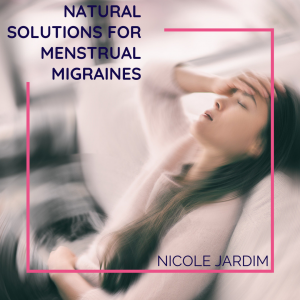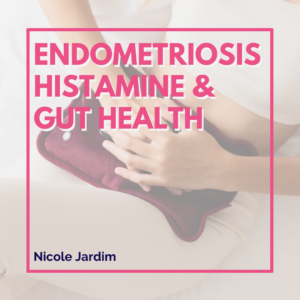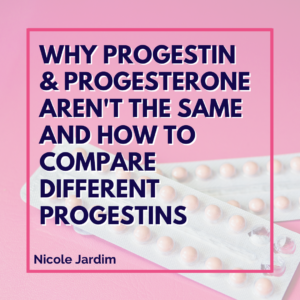Migraine headaches are a health issue affecting women three times more than men. Of the 26 million Americans suffering from migraines, 20 million of them are women and of these 20 million women, 60% of them associate their migraines with their menstrual cycles. This is no coincidence ladies!
For those of you who suffer from menstrual migraines, I don’t need to tell you how debilitating these can be – I often hear tales from many of you about how much they impact the quality of your life.
They are more severe than the normal migraines that people experience and in many cases they are impervious to pain medication. They can literally stop you in your tracks and make your normal daily routine impossible to manage. Sound about right?
What causes menstrual migraines?
There are two leading theories on what might be causing menstrual migraines in many women:
- Hormone Withdrawal: the normal drop of estrogen as part of your menstrual cycle.
- Prostaglandin Release: hormone-like substances that get released into your body prior to your period, which stimulate inflammation and subsequent pain.
How Hormone Withdrawal can Cause Menstrual Migraines:
The dramatic decline in estrogen in the run up to your period is completely normal, yet for some women, it is a trigger for migraines or headaches, especially if there is an imbalance between levels of estrogen and progesterone.
Some studies show that progesterone could be preventative but many women have reported to me that it has worsened their symptoms. Additionally, many women have chronic headaches during pregnancy because of their high levels of progesterone.
So this got me digging some more, and I found a study that indicated there is a threshold of progesterone and estradiol that, if crossed in many women, can trigger migraines. For instance, if your progesterone levels go above or below a certain level, this could provoke or prevent a migraine.
This explains why progesterone therapy works so well for some and doesn’t work for others and why it’s so important to make sure you’re getting the exact right amount that works for your unique physiology.
You can get your progesterone levels tests with this at home test from Lets Get Checked. Be sure to use code Hormones20 to get 20% off the price of the test.
It was also noted within this study that when estradiol levels dropped below 45-50pg/mL during the premenstrual time, this triggered migraines.
Essentially, this means you have to experiment to see what works for you. Get your hormones tested first (use code Hromones20 to get 20% off all tests). If you are estrogen dominant you might want to focus on optimizing estrogen detox pathways in the body and raising your progesterone to see if that helps your headache or migraine problem. If you have too much progesterone, the goal would be to raise your levels of estrogen.
Note: Estrogen has been shown to strengthen our brains, assist in neurotransmission and act as a buffer for pain. So while a decrease in estrogen levels, in itself, won’t cause us discomfort, it could leave some of us much more sensitive to pain.
Prostaglandins and Menstrual Migraines:
Prostaglandins are lipids that have hormone-like effects. They are found in every organ in the body and their main job is to deal with infections and injuries. When they are activated they trigger inflammation, pain and fever in the injured part of the body in an attempt to heal the damaged area.
When there is bleeding involved, prostaglandins stimulate the formation of blood clots and also contract the muscles around the damaged area to prevent blood loss. As you can see, this is a good thing for when we have an injury.
When a woman begins to shed her endometrial lining this triggers the release of a large amount of prostaglandins. In a way our bodies perceive our menstrual bleeding as a kind of “injury” and take steps to heal it. The prostaglandins released at the source of the bleeding, in the uterus, will often stimulate muscle contractions which are the cause of the painful cramps many women experience at this time in their cycle.
But here’s the deal – since prostaglandins are located throughout our entire bodies, their impact during this time is not restricted to our abdomens. When their levels surge during our periods (and there are weaknesses in our defenses) they can cause inflammation in other areas, specifically our brains, which will lead to migraines.
Additionally, if a person has inflammation in the gut or other areas, then the prostaglandins released in the run-up to their period will exacerbate these issues (think tossing gasoline on a fire!)
So, in a nutshell, equipping your body with the necessary defenses to counter the rise in prostaglandins will lead to cramp-free and headache-free periods! Got your attention now?
How do we defend against prostaglandins?
Prostaglandins are pro-inflammatory agents so if you are experiencing menstrual migraines then the first thing you will need to do is boost up big time in the right essential nutrients. Cellular damage can’t heal without those! My first recommendation is anti-inflammatory foods.
The best anti-inflammatory foods for your period:
- Curcumin (a powerful ingredient in turmeric) – I recommend making a turmeric paste and eating it every day. You’ll find many recipes online and you can add it to meals, soups and smoothies!
- Omega-3 Fatty Acids – especially those from fatty fish like wild salmon and sardines. Or supplement with 2 capsules of this omega-3 fish oil a day.
- Resveratrol – think red grapes, blueberries, cranberries and bilberries.
- Flavonoids/Phenolics – found in pretty much all fruit and vegetables (eat up girl!) Green tea is a great source of flavanoids too.
In addition to these foods, vitamin E supplementation can also be extremely helpful in reducing the effects of prostaglandins. Vitamin E inhibits the release of something called arachidonic acid, which is one of the main ingredients in prostaglandins, thus targeting these pro-inflammatory trouble makers at their roots.
Studies have found that women taking vitamin E for 5 days during menstruation showed a significant reduction in headache pain and associated migraine symptoms [2].
I recommend a supplement with mixed tocopherols and tocotrienols. Take 400IU/day for four weeks and see if you notice an effect on your pain. Try Blue Bonnet Vitamin E with mixed tocopherols and tocotrienols.
Balance your Omega 6 and Omega 3 fatty acids to alleviate menstrual migraines:
As mentioned above, omega-3 fatty acids are good anti-inflammatory agents. But like all good secret agents, they have a nemesis, and their Dr. Evil goes by the codename Omega-6. Omega-6 fatty acids counteract the positive anti-inflammatory effects of the omega-3 acids so to get the most out of your omega-3s you need to also reduce your omega-6s.
Humans evolved eating a diet that had a 1:1 ratio of omega-6 to omega-3 essential fatty acids. Our modern western diet now has a ratio of 15:1! Our diet is deficient in good omega-3s and heavy on the bad omega-6s. So what does this have to do with inflammation?
Prostaglandins are derived from omega-6 phospholipids so the more omega-6 in your system, the more prostaglandins you release. More prostaglandins, more inflammation!
So, while you add omega-3 rich foods to your diet, it’s imperative that you also try and reduce your intake of foods heavy in omega-6 fatty acids. A good start would be to avoid all vegetable oils (corn, canola, sunflower, safflower), as these have the highest concentration of omega-6s, and switch to coconut oil when cooking.
You can get your Omega-3 levels tested here.
Other tips to naturally relieve menstrual migraines:
Now that you’re taking steps to combat the rise in prostaglandins, the next step is to counter the effects that the drop in estrogen is having on your brain. Remember, estrogen acts as a reinforcement and protector of the brain.
When its levels go down during the luteal phase of your cycle, this leaves your brain vulnerable to the painful effects of the rise in prostaglandins.
To mitigate these effects it’s important to give your brain additional protectors that can step in for the estrogen that’s vacating the premises. For this, increase the amount of magnesium in your diet.
Magnesium is a great brain-booster and, in fact, studies have discovered that 45% of women suffering from menstrual migraines were found to have magnesium deficiencies [3].
Magnesium-packed foods for period pain and menstrual migraines:
- Dark leafy greens – spinach and swiss chard especially
- Pumpkin and sunflower seeds
- Sea vegetables like kelp and dulse
- Black beans
- Almonds, cashews, brazil nuts and pecans
- Cacao or high cacao-content dark chocolate – just one square has nearly 25% of your daily needs
- Avocados
- Bananas
Note: You should aim for about 400mg of magnesium a day. Technically, you just need 2 cups of spinach or swiss chard, ½ a cup of black beans and half an avocado to get your daily magnesium needs met. So easy!
I also highly recommend a magnesium supplement. I love Seeking Health Magnesium Glycinate or Seeking Health Magnesium Malate. In addition you might want to try an epsom salt bath or a magnesium spray (PS. spray this stuff on your face for glowing skin!)
The MTHFR gene mutation and menstrual migraines:
In addition to dietary deficiencies, there is also a genetic component to menstrual migraines. In particular, a mutation in the Methylene tetrahydrofolate reductase (MTHFR) gene has been linked to migraine issues. The MTHFR gene is responsible for the regulation and flow of folate (B9) and vitamins B6 and B12.
A mutation in this gene can cause a decrease in these important vitamins which has been shown to result in increased levels of an amino-acid called homocysteine which leads to inflammation. Numerous studies have now shown that taking vitamin B6, B9 and B12 supplements in their methylated form can help counter the effects of the MTHFR gene mutation and reduce migraines [4].
In addition, I discovered a study [5] that found a genetic variation in the ESR1 gene (an estrogen receptor gene), is also linked to menstrual migraines.
Menstrual migraines are one of the most severe and debilitating conditions brought on by our cycles. The drop in estrogen and the subsequent shedding of our endometrium lining leave us vulnerable to the painful effects of the pro-inflammatory agents that get released during this time.
No woman should have to live through this pain each month. If you are suffering from menstrual migraines I hope this article has helped to shed some light on the causes and potential solutions to the issues you are facing. Take these steps and help your body build up its defenses and I hope you will find a path towards a pain-free future.
Love ya’ll,

Sources:
[1] Ovarian Hormones and Migraine Headache: Understanding Mechanisms and Pathogenesis. http://www.medscape.com/viewarticle/528774_16
[2] S. Ziaei, A. Kazemnejad, and A. Sedighi, “The effect of vitamin E on the treatment of menstrual migraine,” Medical Science Monitor, vol. 15, no. 1, pp. CR16–CR19, 2009.
[3] Mauskop A, Altura BM. Role of magnesium in the pathogenesis and treatment of migraines. Clin Neurosci.1998;5(1):24-27.
[4] S. Menon, R. A. Lea, B. Roy et al., “Genotypes of the MTHFR C677T and MTRR A66G genes act independently to reduce migraine disability in response to vitamin supplementation,” Pharmacogenetics and Genomics, vol. 22, no. 10, pp. 741–749, 2012.
[5] The estrogen receptor 1 G594A polymorphism is associated with migraine susceptibility in two independent case/control groups. http://www.ncbi.nlm.nih.gov/pubmed/15133719




8 thoughts on “Natural Solutions For Menstrual Migraines”
This is the most valuable article I have ever read on menstrual migraines. I have both hormone withdrawal when my estrogen drops and prostaglandin release, as well as the MTHFR gene mutation. I had no idea that prostaglandins affected other parts of the body. It makes so much sense though because around period time I will always get extreme muscles tightness in my shoulders and or neck (which I now know is due to inflammation caused by prostaglandins) that gives me a migraine that just won’t release no matter what medication I take, how much water I drink or how many massages I get. It feels like my nerves are on fire because of how tight my muscles are. What has especially helped me is taking Magnesium Glycinate and Methylated B vitamins as this post recommends. I have also been adding celtic, salt and a fulvic supplement to my water to keep my electrolytes up. I have also started using wild yam cream and applying castor oil to my shoulders and neck for about a week leading up to my period, and a few days after. I don’t know which thing is “the” thing, but this article gave me so many valuable insights into how my body works and what the potential issue could be. Again, I have never heard that prostaglandin thing anywhere else, it was seriously life changing. Thank you!!
Thank you for this helpful information. I have suffered from menstrual migraines for 3 years and have tried progesterone and estrogen supplements, neither of which have worked.
I am planning to add in Omega 3, Curcumin, and Vitamin E. Do I need to take these every day or just the days leading up to my period and during my period? Thanks again!
Very helpful. My daughter suffers so bad from hormone migraines. Going to share this with her. Thank you so much
What an important article!!! I have suffered from migraines for 19 years. It took me about 15 years to realize that most of the migraines (not all) were related to my menstrual cycle. Due to conflicting symptoms, every doctor I saw just prescribed a painkiller (none to help with inflammation) and tell me there is nothing more to be done, which would leave me popping 6-8 strong painkillers a day for weeks on end. I’ve been to every kind of doctor there is and none have ever explained it like you have or what to do about it. In recent years I have come to realize that in the run up to my period and during, I will always gets the same symptoms which result in a migraine no matter what precautions I take. In the last year I discovered Magnesium oil spray which provides amazing relief! My muscles tense up in my neck, shoulders and upper arms and I feel like I’ve been hit by a bus, but massaging the oil into my muscles works faster than any pill and has a lasting effect! I still have many issues to sort out but hope that women far and wide who suffer from menstrual migraines will find your article early on (and some doctors too apparently!). Im immediately going to buy the vitamin e supplement you recommend (I’m already doing a number of the other things, although diet needs more inspiration..) and see what that does! Thank you!
Nicole, I just found your excellent article on menstrual migraines. There are so many helpful suggestions in it, and I will be trying them.
I have a question for you about menstrual migraines. Mine occur both at ovulation and at menstruation. Does this twice-monthly pattern indicate that the headaches are more likely to be triggered by hormonal fluctuations, rather than by prostaglandins? I ask because your article seems to say that the prostaglandins are triggered by menstruation, which of course isn’t occurring during ovulation.
Thanks in advance for any insight you can offer on hormonal headaches that also occur mid-month.
Hi Christina, thanks for your comment!! I am going to guess that your ovulatory migraines are being triggered by the surge in estrogen. You could be estrogen dominant, which would potentially trigger the migraines at ovulation. I have a few articles on this: https://nicolejardim.com/what-is-estrogen-dominance/
Hope this helps! xo
Hello Nicole,
I have recently gone of HBC and am trying to cope as my body tries to figure out what the heck is going on! In the mean time I am suffering from a dull aching migraine headache, I am on day 3 right now. I can keep it at bay with Rx meds, but I know my liver is not happy about all the chemicals I am pumping in to it. I also have the MTHFR gene mutation. I supplement with methyl-folate and methyl-b vitamins. I am going to try to increase the foods that you have suggested. I would love to see more research and information on this topic.
Thank You,
Whitney
Hi Whitney! I am so sorry I didn’t reply to this comment. I hope you are doing so much better now that you have been off birth control for 9 months now. Sending you a big hug!